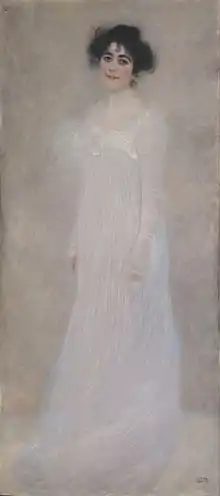Serena Lederer
Serena (Szeréna) Pulitzer Lederer (20 May 1867 in – 27 March 1943 ) was an Austro-Hungarian art collector and the spouse of the industrial magnate August Lederer, close friend of Gustav Klimt and instrumental in the constitution of the collection of Klimt's art pieces.

Early life
Born in Budapest into a wealthy Jewish family (grandniece of the U.S. journalist Joseph Pulitzer), Serena was known for being a beauty in her youth and later a Grande Dame. She married on 5 June 1892 at the Rabbinat of Pest, August Lederer. The family was resident of Raab (Győr), in the Bartensteingasse n° 8 in Vienna and at the castle Ledererschlössel in Weidlingau.
Art
As early as 1888, Gustav Klimt made a first miniature portrait of the young and then unmarried Serena Lederer for his work "Audience Room in the Old Burgtheater".[1] In Vienna, one room of the flat was dedicated to Klimt works. The painting of Szeréna Lederer done in 1899 was the origin of a close friendship. On Klimt's recommendation, in 1912, Egon Schiele was introduced to the Lederer family and became friends with Erich Lederer, the youngest son. Szeréna Lederer was instrumental in the collection of Klimt's work. There are portraits of her mother Charlotte Pulitzer,[2] her daughter Elisabeth Bachofen-Echt [3] and herself by the artist.[4] It has been suggested Elisabeth was the biological daughter of Lederer and Klimt.[5]
According to son Erich Lederer (1896–1985), the residence had been furnished by the Wiener Werkstätte founded by Josef Hoffmann and Koloman Moser in Vienna in 1903. The furnishings had been entrusted to Eduard Josef Wimmer-Wisgrill[6]
Nazi persecution
The Lederer collection was confiscated from Serena in 1940 and she fled to Budapest, where she died three years later. The Gestapo transferred the collection to Immendorf Castle, but the castle was set on fire in May, 1945 so that it would not fall into the hands of the Allies and the collection was destroyed.[4][7] However it is not certain that all the artworks had actually been consumed in the fire as there are reports that some of them reappeared after the war.[8]
Bibliography
- Tobias Natter, Gerbert Frodl (Hsg.): Klimt und die Frauen (Ausstellungskatalog), Dumont Köln 2000 ISBN 3-8321-7271-8
References
- Natter, Tobias G. (2003). Die Welt von Klimt, Schiele und Kokoschka. Sammler und Mäzene (in German). DuMont Buchverlag. pp. 111ff. ISBN 978-3832172589.
- https://commons.wikimedia.org/wiki/File:Klimt_-_Portrait_of_Charlotte_Pulitzer_1915.jpg
- "Elisabeth Bachofen-Echt".
- Gustav Klimt (1899). "Serena Pulitzer Lederer (1867–1943)". work of art: image, references, provenance, notes of history. The Metropolitan Museum of Art.
- Geddes, John (13 August 2020). "The long, dark past behind the National Gallery's latest acquisition". Maclean's. Retrieved 15 August 2020.
- Nebehay, Christian M. (1986). Gustav Klimt Egon Schiele und die Familie Lederer (in German). Bern: Kornfeld Verlag AG. p. 11. ISBN 978-3857730160.
- David Rapp (2004-02-13). "Stealing beauty". Haaretz.
- "Nazi Confiscated Art Issues" (PDF). p. 499. Archived (PDF) from the original on 28 February 2021.